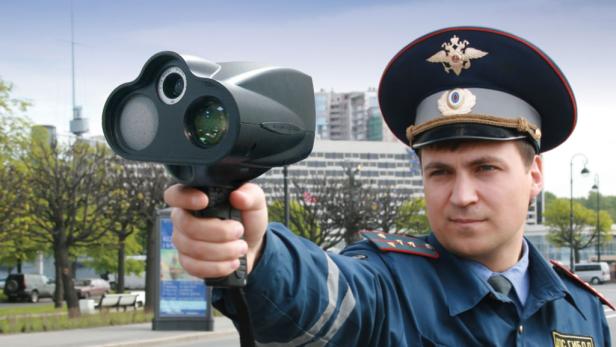
The Many Forms of Radar Boxes
Dieser Artikel ist älter als ein Jahr!
Up until now radar devices have been dull, grey boxes on the street, which look unlikely to contain high-tech equipment. However, at the trade fair Intertraffic in Amsterdam, the future looks very different.
Radar devices are becoming more stylish and smaller. Most of the new devices can detect dozens of vehicles on four or more lanes. They are equipped with touch screens, WLAN and web interfaces. Some devices now only emit a flash in the non-visible infrared range.
Radar and Traffic Light Checks in One
Integrated and high-performance solutions are now the trend, like the T-series device from the Dutch firm Gatso. This looks much more fashionable in its colour combination of black, green and grey. It is mounted on a line and light pole. Inside are hidden two radar antennas with slightly different angles, each able to detect up to 12 vehicles at once. Some staff at the trade fair said up to 70 – but that is best taken with a pinch of salt.
The T-series radar records events on video, with a 20 megapixel camera taking 30 pictures per second via a CMOS sensor. The heart of the device is a CPU with four Intel Atom processors. There is also a Xenon-flash as the infrared-emitter. The device can be controlled by a web-software. Besides speed control, the system includes red-light monitoring as well. So, vehicles which pass a red light phase are recorded.
Columns instead of Boxes
Compared to the T-series radar the radar traps from the Australian firm Redflex appear enormous. These high, but elegant, black columns with a patterned, grey coat in an alloy look were on display at Intertraffic. The basic version is considerably higher, but slimmer, than ordinary boxes. Depending on the requirements, the columns can be increased in height. The technology can scan up to six lanes and – like their Dutch competitor – catch those who jump red lights. But Redflex try to convince clients of the benefits of so-called point-to-point systems, known in Austria as section control.
The German radar producer Jenoptik as sees section control as an important alternative solution for the future. The only mobile section control device in Austria is made by Jenoptik. But the top German product is currently the TraffiStar S350 system. In terms of safety this far exceeds the capacity of the Austrian radar boxes. The thick, four- to five-metre high black and white columns contain –depending on the client`s needs – any number of laser sensors, mounted at about hip-height.
Laser Technology
The lasers have - in comparison to a radar sensor – the advantage, that they can differentiate between various categories of vehicles, and so monitor different speed limits for cars and lorries. The TraffiStar S350 can also scan multiple lanes, but some vehicles might be hidden by others because of the low height of the mounting and the fanning out of the lasers.
A traditional radar device scans 3D-pictures, and therefore can be mounted higher and cover a wider area. Incidentally these lasers should not be confused with spot lasers, mostly used in radar pistols. A spot laser generally focuses on the best-reflecting part of a vehicle – the number plate.
Miniaturisation
Along with these improvements in technology is the miniaturisation of speed-measuring devices. The Swedish firm Sensys is pushing mobile-stand radars. As the firm emphasizes, mobile devices offer large cost benefits for operators. Their Mobile Speed Safety System scans up to three lanes automatically.
Depending on the place and time of an event one can connect an additional flash device and an additional battery, in the same retro design, to the MSSS. The device has an integrated WLAN transmitter and can transmit the speed offences it records to the mobile devices of the operators. Additionally the MSSS handles number-plate recognition and therefore can be used to trace offenders.
Russian producers are currently at the forefront of this miniaturisation trend. Olvia from St Petersburg has won innovation awards for its radar device Merlin. Merlin is a casket that is mounted on poles or masts. Up to four lanes can be scanned and recorded on video, taken at 25 frames per second. Because of its small dimensions, it is necessary to combine it with an additional processor, run on a Windows-based software package. Merlin currently is undergoing a certification process but deliveries should start in 2013.
Radar Pistols from Russia
The smallest radar pistol in the world is already being used in Russia. This is manufactured by the Russian company Simicon and is named Radis.
The device looks like a taser and weighs only 240 grams. It can measure the speed of any object moving between 10 and 300 kmh. If more than one object is in the scan range the fastest is selected automatically.
As the representatives of Simocon proudly emphasize, the device has proved its worth since 2005. Not only can it monitor cars and lorries, but also speeding pilots of speedboats as well as cable car drivers are caught now and then. The radar pistol is available for both the police and on the free market for about € 600.
The latest Somicon product is an advanced radar pistol called Binar. This has two cameras (one a wide-angle colour camera, the other a black and white camera with a detailed zoom) as well as a touch screen. Binar allows the user to focus on one single object in great detail. The double camera equipment enables you to get a clear recording of a number plate from a distance of 150m. Videos are recorded on a SD card. The device can be connected to an optional GPS transmitter via Bluetooth and so can be used in (moving) police cars.
Kommentare